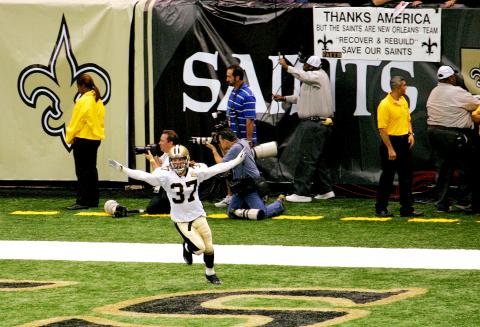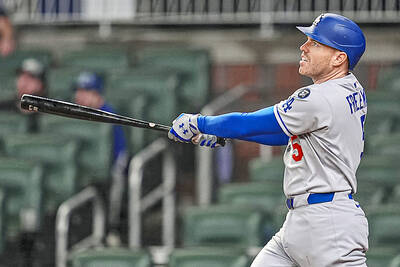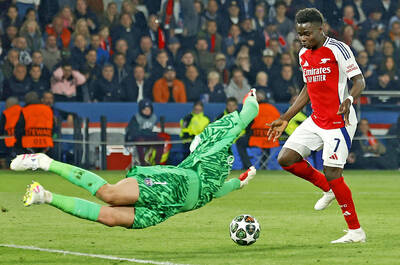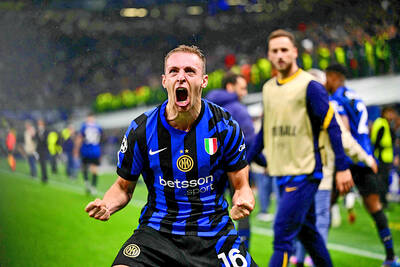Since 2011, Steve Gleason has traveled to Machu Picchu in Peru, road-tripped from New Orleans to Alaska and started a non-profit organization. He also became a consultant for Microsoft and collaborated on a movie that was accepted by the Sundance Film Festival — even though he gradually lost the ability to talk and became paralyzed except for his eyes.
Gleason has amyotrophic lateral sclerosis (ALS), also known as Lou Gehrig’s disease, a motor-neuron disease that afflicts an estimated 20,000 Americans. Patients lose muscle control, which eventually causes difficulty in swallowing and breathing. There is no cure or even an effective treatment; the average life expectancy is between two and five years after the diagnosis.
“The disease takes away your entire physical body and almost always leaves your mind and eyes intact,” Gleason wrote in an e-mail. “When diagnosed with ALS, most people are expected to fade quietly away and die.”

Photo: AP
He decided to forge a different path.
Gleason, 38, played football for the New Orleans Saints for eight years, rising to local-hero status and gaining national fame in fall 2006 when he made a play that led to the team’s first touchdown in the first game played in New Orleans after Hurricane Katrina. (A bronze statue of him was later erected outside the Superdome.)
A couple of years after his 2008 retirement, he began to experience twitching in his arms, shoulders and back, and weakness in his arms. Then, one day, something strange occurred during one of his routine workouts.
“He was doing sprints one day and suddenly just fell over,” said Clare Durrett, an associate executive director of his non-profit organization, Team Gleason.
In the months that followed, he continually lost his footing and experienced other symptoms.
As is common among people with ALS, the diagnosis took about a year; that is because there is no test for the disease. The only way to determine that someone has ALS is to test for and rule out a range of other diseases.
“After I was diagnosed, I did some research and found those who were living, and living with purpose, despite their diagnosis, were doing so through the use of technology,” Gleason wrote.
According to the ALS Association, 75 percent of those with the disease require assistance to communicate. New devices, many of them making use of eye-tracking technology, have allowed patients to describe their symptoms to doctors, caregivers and family members, ensuring they receive better medical care, and have also enabled them to resume some of their hobbies and stay in contact with people via social media, lessening the isolation of the disease.
Gleason had always been tech-savvy, and when he realized he would soon lose the use of his fingers, he tested the assistive technologies available for ALS patients at the time. He found they were not fast or powerful enough, and many tablets were not compatible with eye-tracking technology, he said.
In 2014, he was tapped to appear in Microsoft’s first Super Bowl commercial.
Afterward, he asked the company to make its Surface Pro 2 tablet, which was featured in the advertisement, but was not enhanced for people with ALS, more useful for people with disabilities.
To his surprise, Microsoft agreed. The company flew him to a Microsoft hackathon in Seattle, where he challenged its corps of technologists to come up with a chair he could drive with his eyes. Twenty-four hours later, they produced a prototype. Microsoft then hired Gleason as a consultant as it proceeded to fine-tune the chair and improve the tablet’s compatibility with eye-gaze technology.
The chair, not yet available to the public, is Gleason’s sole mode of transportation. He types using a Microsoft Surface Pro 3 equipped with a panel that has an infrared camera and rests at the bottom of the tablet, made by a company called Tobii Dynavox. The camera follows his eye movements. He uses his eyes the way another person would use a finger to tap on the tablet. He opens an app by setting his gaze on the icon for it, and he types by looking at a digital keyboard on the screen and staring at each letter or number he wants for two-10ths of a second. He types 20 words per minute; 40 words per minute is widely considered to be the average typing speed for people using their hands.
“I can do anything an ordinary person can do on a tablet computer,” he wrote. “Talk, videoconference, text, stream music, buy Christmas presents online, pay bills, tweet.”
He can also drive his wheelchair and take selfies. He used his iPhone and a GoPro camera to record thousands of hours of his life for his son, who was born the year of his diagnosis, to watch in the future. The video was used to make the film Gleason, which is to premiere at the Sundance Film Festival this month.
However, many ALS patients cannot afford such tech tools, and health insurance does not always cover them. Communication devices like Gleason’s cost between US$12,000 and US$20,000. So through Team Gleason, he distributes technology to those in need and coordinates training sessions led by speech pathologists in how to use it.
The organization has disbursed about US$2.4 million in devices and training so far, according to Durrett.
Last year, the group successfully pushed for passage of the Steve Gleason Act, which ensures full access to eye-tracking and speech-generating devices through Medicare.
Next month, Team Gleason is to begin operating a residence in New Orleans for people with ALS and other neurodegenerative diseases called the Team Gleason House. The 18 residents selected to live there are to be able to use tablets not just for communication, but also to adjust the height of their beds, open and close doors, turn on TV sets and change the channels.
The purpose of the house is to “allow ALS patients to be productive and purposeful,” Gleason wrote.
Chase Bank, along with New Orleans Saints owner Tom Benson, have helped finance it.
The non-profit ALS Association, which was one of the main beneficiaries of the US$220 million generated by the ALS Ice Bucket Challenge in 2014, is using some of those donations to spur technological development as well. In November last year, it announced it would award several grants totaling at least US$500,000 to hardware and software developers with the most innovative new technology for people who cannot speak or use their limbs.

Freddie Freeman homered and drove in four runs, Shohei Ohtani also went deep and Roki Sasaki earned his first major league win as the Los Angeles Dodgers beat the Atlanta Braves 10-3 on Saturday night for their seventh straight victory. The Dodgers have won the first two games of the series to improve to 5-0 against Atlanta this year. Los Angeles’ three-game sweep at home early in the season left the Braves 0-7. Sasaki allowed three runs and six hits over five innings. The 23-year-old right-hander gave up a home run to Ozzie Albies, but received plenty of offensive support in his

INTER AWAIT: Superb saves by PSG ’keeper Gianluigi Donnarumma inspired the victory, as Arsenal were punished for misses, including one by Bukayo Saka Arsenal on Wednesday fell short on the big stage again as their painful UEFA Champions League semi-final exit against Paris Saint-Germain left Mikel Arteta to rue his club’s failure to provide him with enough attacking options. Arteta’s side were unable to reach the Champions League final for the first time in 19 years as PSG clinched a tense 2-1 win at Parc des Princes. Trailing 1-0 from last week’s first leg in London, the Gunners made a blistering start to the second leg, but could not convert their chances as Gianluigi Donnarumma’s superb saves inspired PSG’s 3-1 aggregate victory. Arsenal were punished for

Bayern Munich on Sunday were crowned German champions for the 34th time, giving striker Harry Kane his first major trophy, after second-placed Bayer 04 Leverkusen drew 2-2 at SC Freiburg. Bayern’s 3-3 draw at RB Leipzig on Saturday, when the Bavarians came from two goals down to take the lead before conceding a stoppage-time equalizer, meant defending Bundesliga champions Leverkusen needed to win at Freiburg to delay the title party. Leverkusen were two goals down before scoring twice in the final 10 minutes, but Xabi Alonso’s side could not find a third, as Bayern reclaimed the title at the first attempt after

THRILLER: Raphinha gave Barca a 3-2 lead with two minutes remaining of regular time, but Francesco Acerbi equalized the game in the second minute of added time Davide Frattesi on Tuesday fired Inter into the UEFA Champions League final with an extra-time winner that gave the Italians a stunning 4-3 triumph over Barcelona, 7-6 on aggregate. Italy midfielder Frattesi won a tie for the ages under a downpour in Milan when he lashed home in the 99th minute, sending a packed and rocking San Siro wild with joy. Simone Inzaghi’s team will face either Arsenal or Paris Saint-Germain at the end of this month in Munich, Germany, where they would feel they have a great chance to be crowned kings of Europe for a fourth time after